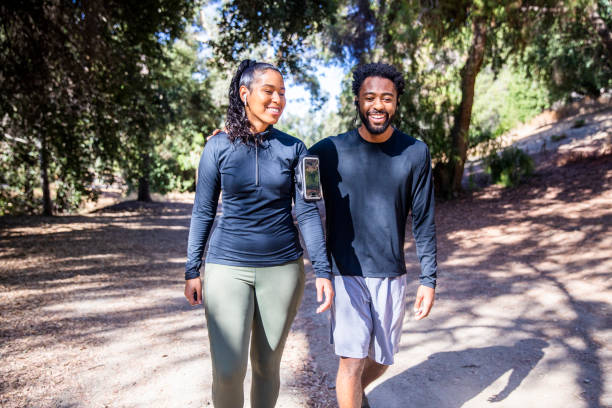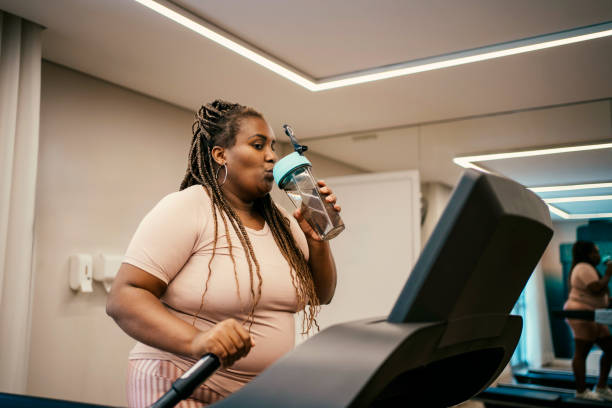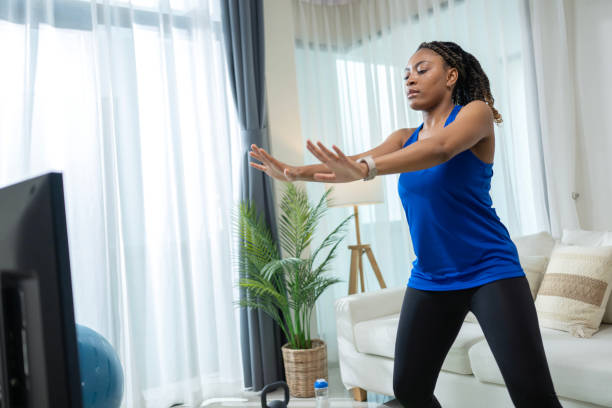(BlackFitness101.com) There comes a moment in every fitness journey when you realize the body doesn’t bounce back like it used to. For many African Americans, that moment often arrives around 40. The aches linger longer, the pounds seem to cling tighter, and the energy levels don’t spike like they did in our 20s. But that doesn’t mean we stop — it means we evolve. As a Black fitness trainer who has worked with clients across generations, I can say with confidence: fitness after 40 isn’t about slowing down, it’s about getting smarter.
Let’s be real — our community already faces a unique set of health challenges. African Americans are disproportionately affected by hypertension, diabetes, obesity, and cardiovascular disease. Much of this is rooted in generational trauma, environmental injustice, systemic barriers to healthcare, and culturally-influenced eating habits. But exercise? Exercise is our reclamation. It’s how we take control of our health story and redefine what aging means for us.
So, how should your workout change after 40? Here’s a deep dive into what to focus on, what to adjust, and how to keep thriving — mind, body, and soul.

1. Strength Training Becomes Non-Negotiable
After 40, strength training isn’t optional — it’s essential. That’s not just gym talk; it’s biological fact. Sarcopenia, the age-related loss of muscle mass, typically begins in our 30s and accelerates with each passing decade. For African Americans, who may start with greater muscle density, the decline can be deceptive because we may still appear strong on the outside. But beneath that surface, the functional power needed to prevent injury, maintain independence, and regulate metabolism is slipping away unless we do something about it.
Beyond maintaining muscle tone, strength training helps regulate blood sugar, improves insulin sensitivity, supports joint health, and even boosts mental clarity. And let’s be honest — ain’t nothing wrong with filling out that shirt or dress a little better too.
This is especially critical for Black women, many of whom carry the burden of caretaking and may neglect their own health until a crisis forces them to stop. Post-menopausal women face a steep drop in estrogen, which can lead to bone loss. Resistance training becomes not just helpful, but protective.
What to do:
Begin with a mix of compound lifts and isolated movements. Think squats, deadlifts, rows, but also add in shoulder presses, glute bridges, and planks. Don’t fear the dumbbells or cables — they’re your allies. Work in reps and sets that build strength (e.g., 3 sets of 8–12 reps) while leaving room for recovery.
Rotate muscle groups throughout the week to give your body time to heal. For example, legs on Monday, upper body on Wednesday, full-body on Saturday. And don’t be afraid to lift heavier over time. Progressive overload (gradually increasing the resistance) keeps muscles challenged and growing.
Trainer Tip:
Invest in one or two sessions with a certified trainer who understands how the Black body responds to strength training — especially in midlife. They can help you develop a plan that meets your needs and respects your limitations while pushing you to grow.
2. Prioritize Joint Health and Mobility
If you’ve ever felt a twinge in your knee after squatting to pick something up or noticed your hips tightening after sitting too long, you’re not alone. Aging brings reduced collagen production, cartilage wear and tear, and stiffening of connective tissue. Add in years of under-stretching, and suddenly your favorite workout becomes a risky move.
This is even more serious for African Americans who are at a higher risk of developing osteoarthritis and other joint issues due to a combination of genetic factors, previous injuries, and health disparities. If you’ve had a history of physically demanding work or been an athlete, your joints might be more worn than you think.
What to do:
Commit to at least 10–15 minutes of mobility work every day, even on rest days. Incorporate shoulder circles, deep squats (assisted if needed), ankle rolls, and cat-cow stretches. Your warm-up should never be a throwaway — it’s your body’s invitation to move safely.
Invest in tools like foam rollers, lacrosse balls, and yoga blocks. Try mobility programs that target pain points, especially in your knees, hips, shoulders, and lower back.
Trainer Tip:
Your best friend post-40 is prehab — not rehab. That means working on weak links before they become problems. Do prehab circuits at least once a week that include balance work, single-leg strength exercises, and shoulder mobility drills. Prevention saves you time, money, and pain down the line.
3. Cardio with Purpose — Not Punishment
It’s time to retire the idea that cardio is just a way to “burn off” the food we ate. After 40, cardio serves a deeper purpose: preserving heart health, managing stress, and keeping the metabolism humming. This is particularly important in our community, where hypertension, heart disease, and high cholesterol are far too common.
Too many of us still carry generational trauma — the kind that quietly elevates cortisol and keeps our bodies in “fight or flight” mode. Done right, cardio can actually help reduce that stress hormone, improve sleep, and elevate mood.
What to do:
Cardio doesn’t have to be high-impact or boring. Walking with intention (arms swinging, pace brisk), dancing in your living room, hiking, cycling, even water aerobics — these all count. Mix steady-state cardio (like a 30-minute brisk walk) with interval training (short bursts of effort followed by recovery).
Two to three 30-minute sessions a week can go a long way. Build up gradually. If you’re carrying extra weight, your joints will thank you for choosing elliptical machines or swimming over jogging.
Trainer Tip:
Use a heart rate monitor to train in different heart rate zones. This helps you avoid overtraining and makes your sessions more efficient. Training in Zone 2 (roughly 60–70% of your max heart rate) improves your cardiovascular base — critical for long-term health and endurance.
4. Focus on Functional Fitness
Functional fitness isn’t about doing circus tricks at the gym. It’s about moving your body in ways that help you thrive in real life. For our parents and grandparents, “working out” often meant physical labor. But in today’s world — with desk jobs, long commutes, and screen time — we have to train movement patterns that daily life no longer reinforces.
Functional training becomes even more vital after 40 when mobility declines and balance weakens. For Black folks, who are often caregivers and community builders, staying strong and capable is more than just personal — it’s cultural.
What to do:
Add in movements that cross the midline of the body, challenge your balance, and activate your core. Examples include kettlebell swings, Turkish get-ups, bear crawls, and step-downs. These types of exercises prepare you for daily demands — carrying a child, lifting groceries, or climbing stairs.
Work in multi-planar movements — those that move the body forward, backward, laterally, and rotationally. Life doesn’t happen in straight lines, so your workout shouldn’t either.
Trainer Tip:
If you want a litmus test for functional strength, try this: Can you get down on the floor and back up without using your hands? If not, that’s your goal. The ability to move independently is a key predictor of longevity. Incorporate exercises that build toward that independence.
5. Recovery is Everything
If strength training is the engine and cardio is the fuel, recovery is the oil that keeps everything running smoothly. Without it, even the best-designed fitness plan will eventually break your body down. This hits different after 40 — trust me.
Recovery isn’t laziness. It’s strategy. Black men and women often operate under “go mode” 24/7 — whether it’s grinding at work, handling family responsibilities, or simply surviving. That level of stress wears down the body over time. Your recovery routine is how you rebuild, re-center, and recharge.
What to do:
Make recovery a scheduled part of your training — not an afterthought. Get 7–9 hours of sleep per night. Take magnesium to help muscle relaxation. Practice deep breathing, progressive muscle relaxation, or guided meditations. Make hydration a priority.
Listen to your body. If you’re sore for more than 48 hours after a workout or constantly fatigued, that’s not strength — it’s burnout. Take a deload week every 6–8 weeks to reduce intensity and allow your system to reset.
Trainer Tip:
Create a weekly recovery ritual. That might include Sunday foam rolling sessions, Thursday sauna visits, or Monday morning walks without music — just you and your breath. These small moments accumulate into long-term vitality.
6. Nutrition Must Match the Effort
You’ve heard it before: “Abs are made in the kitchen.” But truthfully, it’s deeper than aesthetics. Especially for those of us over 40, nutrition becomes the foundation of everything — energy, hormone balance, recovery, disease prevention, and even mental clarity. You can’t grind in the gym all week and then throw it all away on high-sodium, processed foods or constant fast food runs. The truth is, many African American families have grown up on “survival” food: hearty, filling meals born out of love but shaped by economic and historical limitations. The time to upgrade is now — for health, not vanity.
For Black men and women over 40, poor nutrition can intensify health issues that are already disproportionately high in our community: diabetes, high cholesterol, and hypertension. But this isn’t about guilt — it’s about reclaiming our relationship with food. It’s about turning our plates into medicine and making every meal an investment in our future selves.
What to do:
Incorporate lean proteins like grilled chicken, salmon, tofu, or legumes to support muscle recovery. Load up on fibrous vegetables like collard greens, kale, broccoli, and okra — they’re not only filling but also help regulate blood sugar and cholesterol. Limit refined carbs and opt for complex sources like sweet potatoes, brown rice, and quinoa.
Also, rethink your snacks. Instead of chips, try a small handful of almonds or Greek yogurt with berries. Instead of soda or fruit juice, go for infused water with lemon, mint, or cucumber. Hydration alone can significantly reduce fatigue and muscle cramping, especially in the heat of a good workout.
Trainer Tip:
Meal prep on Sundays with a cultural twist. Roast some seasoned chicken, prep sautéed greens with garlic and olive oil, bake yams with cinnamon instead of sugar. Remind yourself that this isn’t about abandoning your roots — it’s about refining the recipe to protect your health without sacrificing flavor.
7. Train Your Mind Like You Train Your Body
Let’s normalize this truth: therapy and fitness are both tools for survival, especially in the Black community. We’ve spent generations carrying stress — from systemic racism to generational trauma — and it often shows up in our bodies before we even realize it’s in our minds. Tight shoulders, poor sleep, lack of motivation — these can all be signs that your mental health needs attention.
Exercise is one of the most powerful mental health tools we have. It increases serotonin, dopamine, and endorphins — neurotransmitters that promote happiness and fight depression. When you pair movement with mindfulness, you’re not just building muscles — you’re building emotional resilience.
What to do:
Integrate mindfulness into your workouts. That could mean taking 5 minutes before or after to stretch with intention, focusing on your breathing, or simply acknowledging how your body feels. Consider journaling after your sessions. Ask yourself: Did I feel strong today? Was I present? What am I grateful for?
Incorporate exercises that feel good emotionally. For some, that’s heavy lifting. For others, it’s long walks, dance, or stretching under sunlight. Movement should feel like therapy — not torture.
Trainer Tip:
If you’re feeling unmotivated, don’t isolate. Join a local Black-owned gym or wellness group. Find a fitness class led by someone who looks like you and understands your experience. Community is medicine. Accountability is love. Healing can happen in the gym just as much as it can on a therapist’s couch.
8. Address Hormonal Shifts
The 40s are when the body’s internal chemistry begins a quiet revolution. And for many of us, it’s a change we weren’t warned about. For Black women, perimenopause and menopause can lead to sleep disturbances, weight gain, hot flashes, irritability, and mood swings. For Black men, lower testosterone levels can bring fatigue, loss of libido, depression, and difficulty retaining muscle mass. These aren’t signs of weakness — they’re biological shifts that require a strategic response.
Too often, hormonal imbalances are misdiagnosed or overlooked in the Black community. Symptoms get brushed off as aging, or worse — laziness. But our hormones dictate so much more than we realize. Energy, mood, recovery, weight regulation, and even mental clarity are all tied to hormonal health.
What to do:
Focus on consistency with your workouts, as regular movement supports hormonal regulation. Eat foods that support hormone balance — flaxseeds, walnuts, cruciferous vegetables (like broccoli and cauliflower), and healthy fats like avocados and olive oil. Avoid excessive alcohol, caffeine, and processed sugar — they disrupt hormonal homeostasis.
Make sleep a non-negotiable. Aim for 7–9 hours nightly and protect your sleep environment like it’s sacred. Use blackout curtains, turn off screens an hour before bed, and keep a regular sleep schedule. Hormones need deep, restorative sleep to do their job.
Trainer Tip:
Ask your doctor for a hormone panel if you’re experiencing mood swings, low energy, stubborn weight gain, or sleep issues. Get your thyroid, cortisol, testosterone, and estrogen levels checked. Advocate for yourself. Partner with a Black healthcare provider or naturopath if possible — someone who listens, understands, and will work with you, not dismiss your concerns.
9. Track Progress Differently
One of the biggest mindset shifts we need after 40 is letting go of the scale as our sole measure of success. The truth is, your weight may not change dramatically — and that’s okay. The real transformation is happening inside your body and in how you function daily. Especially for African Americans, whose body types are often misrepresented in fitness marketing, it’s important to celebrate progress that doesn’t fit a Eurocentric mold.
We’ve been taught to look for six-packs and tiny waists, but we need to honor healthier blood pressure, greater mobility, fewer sugar cravings, and the ability to get up off the floor without help. That’s real power.
What to do:
Track how you feel in your clothes. Notice whether stairs feel easier. Keep a log of your blood pressure, resting heart rate, sleep quality, mood levels, and stress response. These markers are gold.
Take photos monthly — not to criticize yourself, but to celebrate visible progress. Document how your skin looks, how upright your posture is, how strong your legs are becoming. Progress is so much more than numbers.
Trainer Tip:
Set intention-based goals, not appearance-based ones. For example:
- “I want to walk 3 miles without getting winded.”
- “I want to lower my A1C by my next doctor’s visit.”
- “I want to do 15 pushups without stopping.”
You’ll find more joy in the journey and be less likely to burn out or self-sabotage when the scale doesn’t budge.
10. Make it Cultural, Make it Fun
Fitness after 40 should feel less like a chore and more like a celebration. If you dread your workout, you’re less likely to stick with it — that’s just facts. But when movement is tied to joy, rhythm, and community, it becomes part of your lifestyle.
For Black folks, movement has always been cultural — from stepping and double dutch to drum circles and line dancing. Our bodies have always told stories through movement, and fitness is a natural extension of that.
What to do:
Explore workouts that honor your roots. Try an African dance class or an Afro-Caribbean aerobics session. Host family “fitness Sundays” where you blast old-school music and get active in your backyard. Use jump ropes, do relays, or even bring out the hula hoop.
Incorporate fun into your week. Dance in your kitchen while meal-prepping. Walk to your favorite playlist. Use apps that gamify fitness — competition and music can be powerful motivators.
Trainer Tip:
Curate a vibe before you train. Light incense, play gospel or trap soul, wear your favorite hoodie or tee. When you love the space you’re working out in — mentally and physically — you stop resisting movement and start flowing with it.
Reaching 40 isn’t the end — it’s a new chapter. A lot of us have spent our earlier years grinding: raising families, working jobs, sacrificing ourselves for others. But after 40? This is your time to focus on you.
Working out in your 40s as a Black man or woman isn’t just about biceps or booty gains. It’s about reclaiming health in a system that often fails us. It’s about honoring ancestors who didn’t have access to gyms or whole-food diets. It’s about showing the next generation that aging doesn’t mean decline — it means power, purpose, and presence.
Whether you’re just getting started or recommitting to your health, know this: you deserve to feel good. You deserve to feel strong. You deserve a future where your body carries you with pride, not pain.
Change your workout. Change your life. Because 40 is not the beginning of the end — it’s the start of your second prime.
Staff Writer; Leroy Smith
With over 20 years of experience in fitness and health education, I specialize in strengthening the body while empowering the mind. My mission is to uplift the Black community through movement, knowledge, and sustainable wellness. This is more than just workouts; it’s about reclaiming our health and redefining what strength truly means.
Questions? Feel free to email me at LSmith@BlackFitness101.com.











Leave a Reply